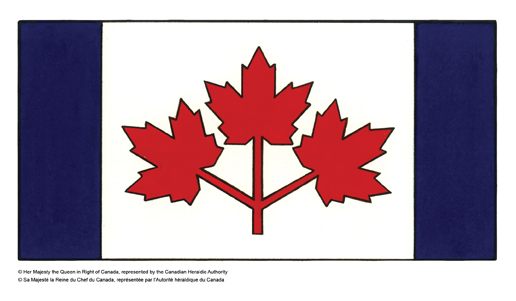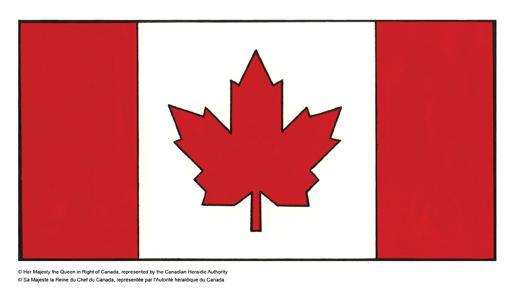
Living flag file photo from BY DAN HARPER.
Marking Canada Day 2018
To commemorate Canada Day, UM Today dug into the archives to bring you some choice morsels from Canadian history.
The quest to create a Canadian flag began in 1925 and continued with the call for submissions in 1946 — receiving more than 2,600 designs, though Parliament never officially voted on a design. It finally resulted in a flag after Prime Minister Lester B. Pearson brought forward the idea once again in 1964.
The flag was based on the iconic combination of red, white and red that first appeared in the General Service Medal issued by Queen Victoria. King George had proclaimed red and white Canada’s official national colours in 1921.
The now-official national flag of Canada came into being due to the initiation of Pearson, Ontario MP John Matheson, who established the conceptual framework for a suitable flag, and Dr. George Stanley, who provided the central concepts of red-white-red stripes with a central maple leaf. Read more about the origins of the Canadian flag here.
Before its official installation in 1965, however, Canadians had many ideas about what the flag should look like (or whether Canada should have one). The 1959 edition of U of M’s student newspaper The Manitoban dedicated some space to that very issue. In fact, they held their own flag contest. One artist sent in a colourful suggestion that used purple, green and gold.
Below are some of the flags that almost represented our nation — and, of course, the flag in its final form.

A Red Ensign with the fleur-de-lis and the Union Jack. // Image from Government of Canada.

Three red maple leaves between two blue borders. // Image from Government of Canada.

The red maple leaf on a white square between two red borders. // Image from Government of Canada.
***
Our question to history profs specializing in Canadian history was: Can you recount one unique historical incident that Canadians may not be aware of, and tell us why it’s important?
We heard this from history professor in the Faculty of Arts, Adele Perry, who’s also Canada Research Chair in Western Canadian Social History:
I would mention the Treaty of Niagara, which was negotiated in July 1764 between members from 24 Indigenous nations and Crown officials. It consolidated the promises of the Royal Proclamation of 1763 and created a new covenant chain between Britain and Indigenous nations, including the Iroquois Confederacy, the Algonquin and he Huron. This was documented in a wampum belt. You can read more about it in John Borrows article “Wampum at Niagara.” The Treaty of Niagara reminds us of the long and important history of negotiations between Indigenous peoples and settler states, something that has today been reconfirmed in the Supreme Court’s decision on the Williams case.
Associate professor of history, Len Kuffert, suggested this historical moment:
One incident that leaps to mind is the voyage of the Komagata Maru. It’s an incident I teach students about, but I’m certain that not very many Canadians know about it at all. It’s particularly relevant right now because the real action was taking place exactly 100 years ago in 1914. What happened?
Canadian immigration regulations have always been ‘flexible’, and the early twentieth century was no exception. The Canadian government at the time, the Conservatives, decided to screen potential immigrants in a new way, requiring them to have arrived in Canada via a “continuous journey”, without any stops to pick up more passengers. Canadian Pacific, which had some steamship routes from various points in Asia, suddenly shut these down. For Asians wishing to come to Canada, this new rule and CP’s decision to cut routes limited where they could embark on their journey, and in effect would prevent many from contemplating making this big move.
A member of the BC Sikh community, Gurdit Singh, leased a ship from some Japanese owners, and brought over 350 passengers, mostly from Punjab, across the Pacific. The voyage clearly violated the continuous journey rule, and Canadian authorities kept the ship, the Komagata Maru, docked in Vancouver Harbour for about two months. During that time, the relatively small Sikh community and supporters made sure that the ship owners were paid, and that the passengers were fed. A tiny proportion of the passengers were allowed to stay in Canada, even though all were British subjects, and should have been granted the right to land. Legal challenges to the Immigration Act failed, and the ship had to depart, but not before a clash between passengers and police in their smaller boats. When the ship returned to India, police there ‘greeted’ it, and in the ensuing riot, about twenty men were killed.
This is not an inspiring, ‘feel good’ story in itself, but it highlights some of the ways Canada and Canadians acted toward those desiring to make new lives here, and reminds us of how new and artificial our communities really are. We have moved on, adopting fairer ways of dealing with potential immigrants and refugees, but it’s imperative to remember those shut out 100 years ago.
Distinguished Professor Emeritus Gerald Friesen suggested the 1870 events at Upper Fort Garry:
Events at Upper Fort Garry in June to July 1870
June 17: Father Ritchot, one of three Red River delegates to the Ottawa negotiations on Assiniboia’s transfer from Britain to Canada, arrives at Upper Fort Garry on the steamer International and briefs Louis Riel on the terms they have arranged for the admission of Red River to Canada
June 23: The Legislative Assembly of Assiniboia convenes to consider the terms of the Manitoba Act
June 24: The Assembly unanimously accepts the terms of union in the Manitoba Act
July 15: The Manitoba Act is proclaimed and Manitoba becomes the first new province in Confederation
The people of the Red River settlement, defined as the area within 50 miles of Upper Fort Garry, through the agency of their representatives sitting as the Legislative Assembly of Assiniboia, voluntarily chose to enter the newly-founded Dominion of Canada in sessions held at the end of June, 1870 and became the first new province in the Canadian Confederation on 15 July 1870.
(The above article is a condensed version of a UM Today piece that originally ran in 2014.)






